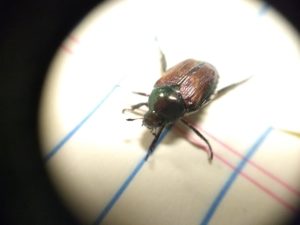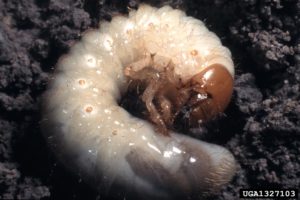White Grub Control
go.ncsu.edu/readext?535147
en Español / em Português
El inglés es el idioma de control de esta página. En la medida en que haya algún conflicto entre la traducción al inglés y la traducción, el inglés prevalece.
Al hacer clic en el enlace de traducción se activa un servicio de traducción gratuito para convertir la página al español. Al igual que con cualquier traducción por Internet, la conversión no es sensible al contexto y puede que no traduzca el texto en su significado original. NC State Extension no garantiza la exactitud del texto traducido. Por favor, tenga en cuenta que algunas aplicaciones y/o servicios pueden no funcionar como se espera cuando se traducen.
Português
Inglês é o idioma de controle desta página. Na medida que haja algum conflito entre o texto original em Inglês e a tradução, o Inglês prevalece.
Ao clicar no link de tradução, um serviço gratuito de tradução será ativado para converter a página para o Português. Como em qualquer tradução pela internet, a conversão não é sensivel ao contexto e pode não ocorrer a tradução para o significado orginal. O serviço de Extensão da Carolina do Norte (NC State Extension) não garante a exatidão do texto traduzido. Por favor, observe que algumas funções ou serviços podem não funcionar como esperado após a tradução.
English
English is the controlling language of this page. To the extent there is any conflict between the English text and the translation, English controls.
Clicking on the translation link activates a free translation service to convert the page to Spanish. As with any Internet translation, the conversion is not context-sensitive and may not translate the text to its original meaning. NC State Extension does not guarantee the accuracy of the translated text. Please note that some applications and/or services may not function as expected when translated.
Collapse ▲This week we’ve received several questions at the Caldwell Extension Center about white grub control in home lawns. White grubs are actually the larvae of scarab beetles.
There are over 30,000 species in the scarab beetle family.
Japanese beetles are the most damaging grubs we see in Caldwell County. However, a relatively new pest, the oriental beetle may become a problem in the future.
Regardless of the species of white grub, they all have cream colored bodies with yellow to brownish heads and six legs. Mature grubs vary in length from 1⁄4 to 1 1⁄2 inches, depending on the species. All white grubs have a very distinct curled, or C-shaped, position.
White grubs have a one-year life cycle and spend about 10 months of that cycle in the ground. The timing can vary a few weeks among the different species, but eggs are laid in early July and the larvae hatch out two weeks later. These larvae feed on grass roots until cool weather arrives in October. In November, the grubs burrow deeper into the soil to over winter. The grubs return to the root zone and begin feeding in March. Larvae pupate, and adults emerge in May and early June to begin the cycle over again.
If there is a history of grub problems in your lawn, preventative treatments can be applied in mid July. Merit® and Mach 2® are two preventative pesticides that can be applied. If you don’t know if you have a grub problem, then it is best to verify that grubs are actually present before applying pesticides.
To scout for potential grub issues, wait until August and use a heavy-duty knife or a spade to cut a 1-square-foot flap of sod and roll it back. Examine the soil and roots in the top 3 or 4 inches. Repeat this process in several locations. If you find an average of five or more grubs per square foot, a curative pesticide application is justified.
Curative treatments applied in late summer or early fall are more effective than spring applications because the grubs are smaller and easier to control. No matter which product or approach is selected, be sure to read and follow label directions.
A biological treatment method, useful against only Japanese beetle grubs, is the application of milky spore bacteria. When this commercially available bacterium is used, it infects the grubs and produces a disease. Grubs in the soil come in contact with the spores through ingestion. The spores germinate inside the grubs, eventually killing them.

Japanese beetle larva are the most destructive white grubs in Caldwell County lawns. The adults are very recognizable with their metallic appearance. These beetles feed on many plants, but roses and grapes are among their favorite.
These spores work best when applied in late September or early October to soil with a pH level between 6 and 7. The results are not as rapid as with chemical insecticides, but the effects last many years.
When milky spore disease becomes established, it will spread naturally to adjoining, untreated areas. This product is available under such trade names as Doom®, Japidemic®, or Milky Spore.
Recent studies indicate that traps for Japanese beetle adults have no impact on the subsequent population of grubs in the soil. The use of Japanese beetle traps can also actually attract adult beetles to the area where they may feed on ornamental landscape plants rather than entering the trap. For this reason, we do not recommend Japanese beetle traps for home landscapes.
For answers to your agricultural questions, call the Caldwell County Extension Center at 828-757-1290 or visit us online anytime at //caldwell.ces.ncsu.edu.





